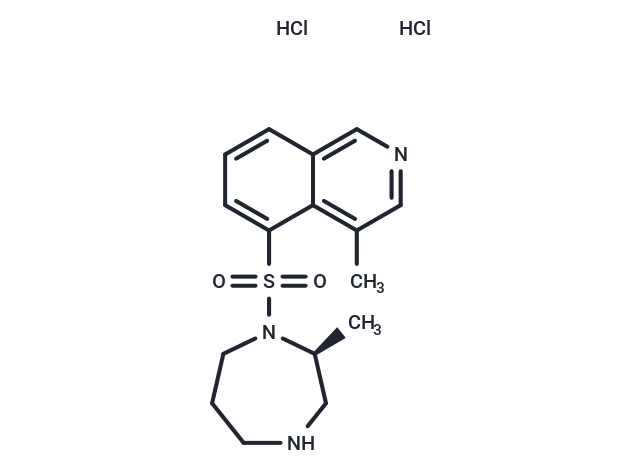Shopping Cart
Remove All Your shopping cart is currently empty
Your shopping cart is currently empty
H-1152 dihydrochloride (H-1152 2HCl) is a specific inhibitor of Rho-associated protein kinase (ROCK) with an IC50 of 12 nM and a Ki of 1.6 nM. H-1152 dihydrochloride inhibits PKA, PKC, PKG, Aurora A and CaMKII with IC50 values of 3.03 μM, 5.68 μM, 0.360 μM, 0.745 μM and 0.180 μM, respectively.

| Pack Size | Price | USA Warehouse | Global Warehouse | Quantity |
|---|---|---|---|---|
| 1 mg | $58 | In Stock | In Stock | |
| 5 mg | $145 | In Stock | In Stock | |
| 10 mg | $239 | In Stock | In Stock | |
| 25 mg | $462 | In Stock | In Stock | |
| 50 mg | $728 | In Stock | In Stock | |
| 100 mg | $987 | - | In Stock | |
| 1 mL x 10 mM (in DMSO) | $158 | In Stock | In Stock |
| Description | H-1152 dihydrochloride (H-1152 2HCl) is a specific inhibitor of Rho-associated protein kinase (ROCK) with an IC50 of 12 nM and a Ki of 1.6 nM. H-1152 dihydrochloride inhibits PKA, PKC, PKG, Aurora A and CaMKII with IC50 values of 3.03 μM, 5.68 μM, 0.360 μM, 0.745 μM and 0.180 μM, respectively. |
| Targets&IC50 | CaMK II (cell-free assay):0.180 μM, Src:3.06 μM, GSK-3α:60.7 μM, Aurora A (cell-free assay):0.745 μM, PKA (cell-free assay):3.03 μM, EGFR:50 μM, PKC:5.68 μM, p38α:100 μM, MLCK:28.3 μM, AMPK:100 μM, ROCK2 (cell-free assay):0.0120 μM, Abl:7.77 μM, PKG (cell-free assay):0.360 μM, MKK4:16.9 μM |
| In vitro | H-1152 dihydrochloride shows less inhibitory activities against Src, MLCK, Abl, EGFR, MKK4, GSK3α, AMPK, and P38α, with IC50s of 3.06, 28.3, 7.77, 50.0, 16.9, 60.7, 100, and 100 μM, respectively[1]. H-1152 dihydrochloride slightly suppresses PKA, PKC and MLCK, with Kis of 0.63, 9.27, and 10.1 μM, respectively. In LPA-treated cells, H-1152 dihydrochloride (0.1-10 µM) inhibits MARCKS phosphorylation (IC50 = 2.5 µM)[2]. H-1152 dihydrochloride (0.5-10 μM) does not decrease neuronal survival or alter the ratios of different neuronal morphologies. H-1152 dihydrochloride (10 μM) arguments neurite length in both BMP4 and LIF cultures[3]. |
| Synonyms | H-1152 dihydrochloride, H-1152 2HCl |
| Molecular Weight | 392.34 |
| Formula | C16H23Cl2N3O2S |
| Cas No. | 871543-07-6 |
| Smiles | Cl.Cl.C[C@H]1CNCCCN1S(=O)(=O)c1cccc2cncc(C)c12 |
| Color | White |
| Appearance | Solid |
| Storage | Powder: -20°C for 3 years | In solvent: -80°C for 1 year | Shipping with blue ice/Shipping at ambient temperature. | ||||||||||||||||||||||||||||||||||||||||
| Solubility Information | DMSO: 40 mg/mL (101.95 mM), Sonication is recommended. H2O: 32.1 mg/mL (81.82 mM), Sonication is recommended. | ||||||||||||||||||||||||||||||||||||||||
| In Vivo Formulation | 10% DMSO+40% PEG300+5% Tween 80+45% Saline: 2 mg/mL (5.1 mM), Sonication is recommended. Please add the solvents sequentially, clarifying the solution as much as possible before adding the next one. Dissolve by heating and/or sonication if necessary. Working solution is recommended to be prepared and used immediately. The formulation provided above is for reference purposes only. In vivo formulations may vary and should be modified based on specific experimental conditions. | ||||||||||||||||||||||||||||||||||||||||
Solution Preparation Table | |||||||||||||||||||||||||||||||||||||||||
H2O/DMSO
DMSO
| |||||||||||||||||||||||||||||||||||||||||
| Size | Quantity | Unit Price | Amount | Operation |
|---|

Copyright © 2015-2026 TargetMol Chemicals Inc. All Rights Reserved.